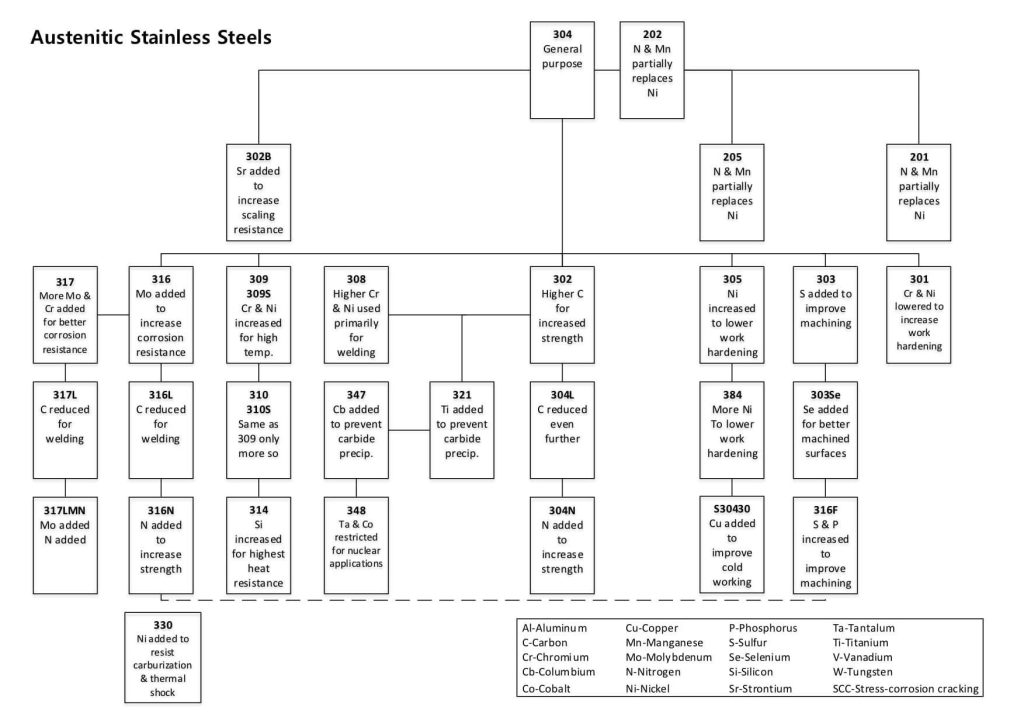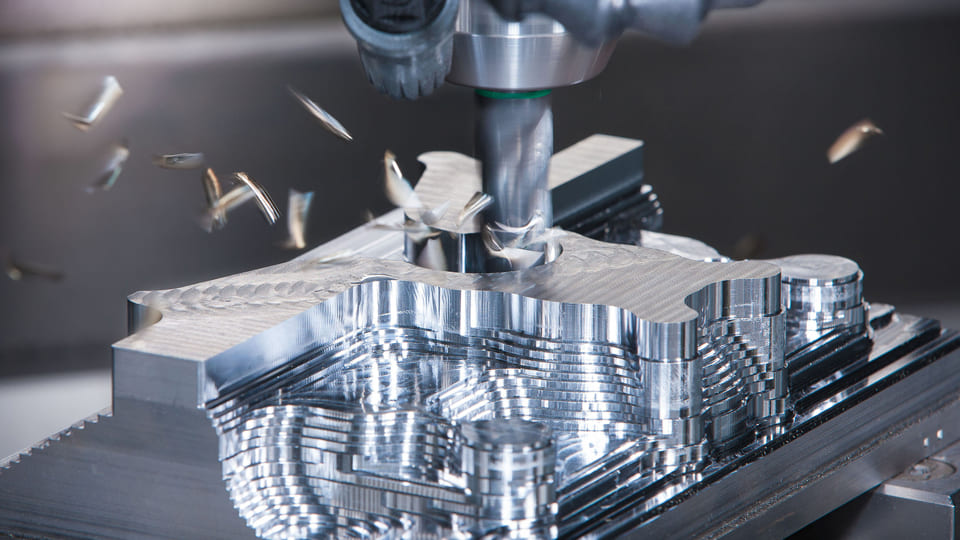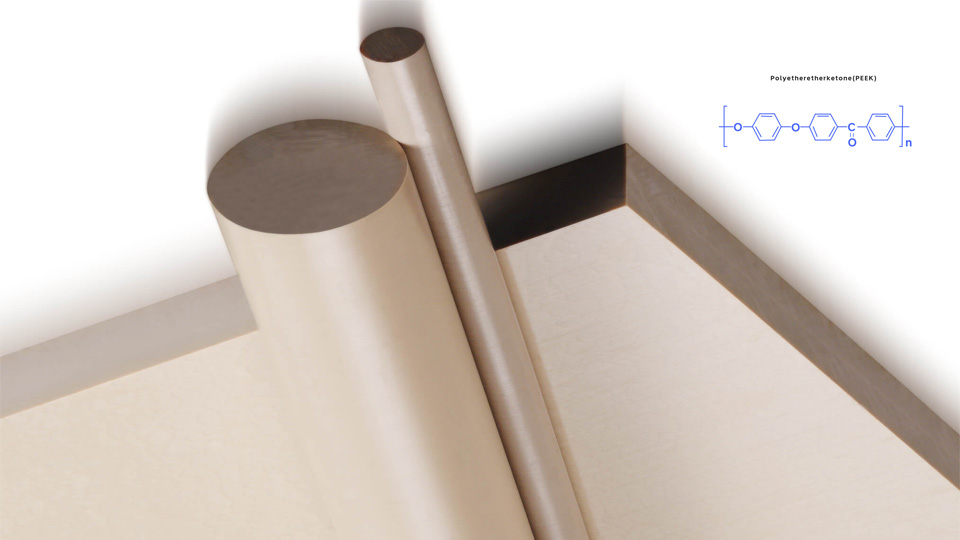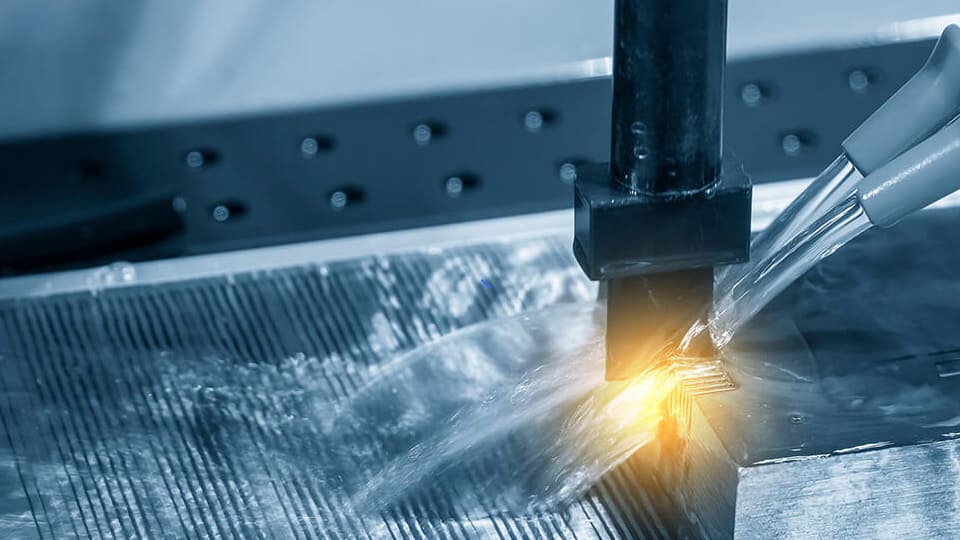Stainless steel is a popular metallic material that is widely used in CNC prototyping. It comes in different types: austenitic, martensitic, ferritic and more. Each of them provides unique properties such as corrosion resistance and high strength. Understanding what they are and their differences is crucial for choosing the right type for various applications.
Microstructure of Steel
Iron is the fundamental element of steel. In its solid state, iron exhibits two crystal structures. One is the body-centered cubic (BCC) structure, which exists within two temperature ranges. It is called α-iron when present below 912 °C and δ-Fe when above 1394 °C. The other is the face-centered cubic (FCC) structure, which exists between 912°C and 1394°C and is called γ-Fe.

Carbon is another major element in steel and plays a crucial role in its microstructure and properties. Generally, as the carbon content increases, the strength of the steel increases while its plasticity decreases. Carbon primarily exists in two forms in steel: one is dissolved in iron, forming a solid solution, and the other is iron carbide, known as cementite (FE3C), which is hard and brittle.
When carbon dissolves in δ-Fe, it is called ferrite, and it retains the body-centered cubic structure. When carbon dissolves in γ-Fe, it is called austenite, and it retains the face-centered cubic structure.
What is Austenitic Stainless Steel?
At room temperature, austenite does not exist independently, and the austenite phase region is small. However, by adding certain metallic elements to steel, the austenite phase region can be expanded, making austenite stable at room temperature and forming austenitic alloy steel.
Austenitic stainless steel is an alloy formed by adding 17%–25% chromium and 8%–25% nickel to carbon steel. Now, let’s look at what stainless steel is. Stainless steel is a type of steel that gains its corrosion resistance through the addition of elements, with the typical characteristic of containing at least 10.5% chromium. Austenitic steel alloys are a category of stainless steel.
Why is austenite stainless steel resistant to corrosion? The addition of nickel allows the steel to exhibit an austenitic structure at room temperature, reducing the number of corrosion cells formed due to differences in microstructure and enhancing corrosion resistance. The addition of chromium forms a dense layer of chromium oxide on the surface of the steel, making it less susceptible to rust. A typical example of austenitic SUS is stainless steel 18-8, which is an alloy containing at least 18% chromium and at least 8% nickel.
The mindmap below shows the grades of austenite stainless steel.

Properties of austenitic stainless steel
Non-magnetis. Austenitic stainless steel is non-magnetic at room temperature, which makes it suitable for applications where there is strong magnetic interference.
Excellent corrosion resistance. Austenitic stainless steel has a well-rounded set of properties, particularly outstanding resistance to oxidizing acids. It can resist corrosion from sulfuric acid, phosphoric acid, formic acid, acetic acid, and urea.
Good Weldability. The high nickel content in austenitic stainless steel contributes to stability and ductility during welding. Nickel helps prevent the formation of brittle phases and enhances the material’s ability to absorb thermal expansion stresses without cracking.
What is Martensitic Stainless Steel?
Martensite is a supersaturated solid solution of carbon in α-Fe. When steel is heated to a certain temperature to form austenite and then rapidly quenched, it results in a very hard crystalline microstructure known as martensite. The transformation begins when austenite reaches the start temperature for martensitic transformation (Ms) and continues until it drops below the transformation temperature (Mt). Generally, the higher the percentage of transformation to martensite, the greater the strength of the resulting martensitic steel.
Put Your Custom Parts into Production Today!
Martensitic stainless steel has a body-centered tetragonal (BCT) crystal structure. Its main composite is chromium (10.5%–18%), but this type of stainless steel contains higher amounts of carbon, and its mechanical properties can be adjusted through heat treatment processes such as quenching and tempering. Martensitic stainless steel is divided into low-carbon martensitic steel (0.05–0.25% carbon) and high-carbon martensitic steel (0.61–1.20% carbon). Low-carbon martensite steel offers better corrosion resistance, while high-carbon martensite steel has greater strength but is more brittle.
The following mindmap illustrates the main alloy grades of martensitic stainless steel.

Properties of Martensitic Stainless Steel
Magnetics. Many types of martensitic steel are magnetic. This is due to the iron content, which gives the crystalline molecular structure magnetic properties. While magnetism makes the metal easier to classify, it complicates welding and other manufacturing processes. Martensitic steel remains magnetic, whether in an annealed or hardened state.
High strength. The hardness primarily depends on the carbon content in the martensite. As the carbon content increases, so does hardness, reaching near maximum levels after quenching when the carbon content is around 0.6%.
Poor corrosion resistance. This is because martensitic stainless steel contains lower levels of chromium and nickel. While it does possess corrosion resistance, martensitic stainless steel is less resistant in harsh environments than its austenitic counterpart.
Adjustable by heat treatment. Quenching can increase the hardness, while tempering reduces brittleness and enhances toughness. By controlling the temperature and duration of heat treatment, manufacturers can tailor the steel’s strength, hardness, and toughness.
What is Ferritic Stainless Steel
When carbon dissolves in δ-Fe, it is called ferrite. It has a body-centered cubic structure. Its carbon solubility is very low, only 0.0008% at room temperature, and the maximum carbon solubility is 0.02% at 727 °C.
Ferritic stainless steel has a body-centered cubic (BCC) crystal structure. It has a high chromium content, ranging from 11% to 27%, but contains little or no nickel and a low carbon content (about 0.03%).
The following mindmap illustrates the main alloy grades of ferritic stainless steel.

Properties of Ferritic Stainless Steel
Magnetic. Among the alloy composites, chromium (Cr) is the component that makes stainless steel magnetic. In contrast, nickel (Ni) inhibits the generation of this magnetism. Ferritic stainless steel has chromium as the main alloy component and does not contain nickel, so it is magnetic.
Good corrosion resistance. Ferritic stainless steel contains a large amount of chromium, which can form a protective oxide layer on the surface to prevent corrosion. However, its corrosion resistance is not as good as austenitic stainless steel. Because ferritic steel has a body-centered cubic (BCC) structure, its capacity for corrosion resistance is slightly higher than the FCC structure of austenitic steel.
Poor weldability. Ferritic stainless steels have higher thermal conductivity. This means they dissipate heat more efficiently, and maintaining the heat required for welding can be challenging. In addition to this, ferritic stainless steels exhibit reduced ductility at lower temperatures, and the welding process involves localized heating and cooling. Such temperature fluctuations can cause embrittlement of the weld joint and reduce toughness.
Comparison: Austenite vs Martensite vs Ferrite
At last, let us use a table to show the differences between ferritic, martensitic, and austenitic stainless steel.
| Property | Ferritic Stainless Steel | Martensitic Stainless Steel | Austenitic Stainless Steel |
| Crystal Structure | Body-centered cubic (BCC) | Body-centered cubic (BCC) | Face-centered cubic (FCC) |
| Magnetism | Magnetic | Magnetic | Non-magnetic |
| Corrosion Resistance | Moderate | Moderate | Excellent |
| Strength | Moderate | High | Moderate |
| Heat Treatment | Cannot be hardened by heat treatment | Can be hardened by quenching and tempering | Cannot be hardened by heat treatment |
| Ductility | Good | Lower ductility | Excellent |
| Weldability | Poor | Poor | Excellent |
| Thermal Conductivity | Higher | Moderate | Low |
| Resistance to Stress Corrosion Cracking | High | Poor | Poor |
| Cost | Lower | Lower | Higher |






